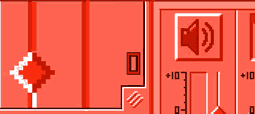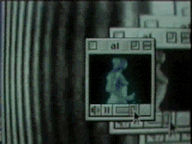Appropriate Technology: Artificial Products, Mediation, and Streaming Media
x 1999
Streaming media embody one of the more prevalent paradoxes of digtial culture: live streaming events over the Web are simultaneously real-time events (in the manner that music concerts or theatre performances are), but they are also saturated with complex notions of distance, absence, remoteness (technological mediations which include networks, bandwidth, software, computer interfaces).

Here the already complex notion of presence is infused with and constituted through technological mediation, a tension inherent within the notion of mediation itself (the distance or buffering which also establishes a connection). Streaming media are thus put into a unique space of immediacy (live, real-time event) and mediation (cybercasting via the medium of computer and networking technologies). Mainstream, commercial media rarely even recognize this tension, presenting media as simply transparent and immediate (we are seing this happen now with the incorporation of RealVideo). One of the tasks of the artist or cultural activist would be, then, to highlight and investigate this tension - a tension not only at the heart of streaming media technology, but a tension indicative of digital culture generally.
When considering new digital and streaming media, this situation of media with respect to cultural activity suggests that streaming media is not so much a technology in itself, as it is a way of intersecting and condensing a variety of already-established models (live TV, radio, video) with developing ones (computer and telecommunications-based networking), and restructing their relative ratios to produce not only new technological objects (interfaces, software applications, streaming media product and content), but also new social contexts that affect the sensory experience of media.
In other words, while a consideration of the possibility of alternative structures of organization for new media is an indispensable facet of making tactical media work, I'd also like to add to this that tactical media can only be fully effective if it is also aesthetically-formally-sensorially tactical as well. This means that, alongside an investigation into creating new distribution or broadcasting models, there must also be a concurrent investigation into the potential challenges, critiques, and experiments which are embodied and materialized in a given media (be it RealVideo, MP3, or Java). Already we are seeing technologies such as RealVideo and CU-SeeMe being restricted to the traditional models of mainstream media (e.g., RealVideo programming based on the TV network; CU-SeeMe reflectors based on the cafe motif; RealAudio used to sell CDs online). Thus it is as pertinent for cultural activists and artists to consider how these new technologies may significantly change what is meant by "performance," "art," or "theater."

While much thought on new and developing media such as RealVideo or MP3 often replays a narrative strain of anxiety very familiar to the historic avant-gardes (innovation, potential revolution, incorporation, recuperation, commodification), an emphasis on the concrete and situational instances of using media suggests that, depsite the hype concerning DIY-culture, a technical ethic of "appropriate technology" still remains a useful and potentially critical tool for the use of streaming media technologies.
In the current, heterogeneous field of streaming media activity, there are (at least) three primary techniques whereby new streaming media technologies are used for critical-aesthetic-tactical purposes:
First, there is the appropriation of Web technology for particular uses which may or may not be previously designated by the technology itself. An example is the use of CU-SeeMe - primarily used in banal situations such as virtual cafes - to "stage" performative streaming media actions. The question in this instance are the potential meanings of (mis)appropriating technology, developed mostly within the software industry, and utilized for predominantly entertainment purposes.
Secondly, there are those instances where a number of technologies are put into a creative relationship with each other, forming a hybrid media situation. An example is the concurrent use of different media performing different functions (e.g., RealAudio streaming sound, CU-SeeMe streaming video, custom-programmed webpages, streaming webcams, Java applications, and IRC text). When this hybrid formation is combined with the first instance described above (given, of course, the always-troubling technical requirements), then interesting situations may develop where a given technology is not limited to it's technical specifications - thus the possibilities of streaming video-text, audio-chat, or web-CUSeeMe arise.
This leads, thirdly, to the possibility of actually producing or coding technology for use in given tactical media situations. Already we are seeing this with the development of alternative browsers, Java applets, and media activist freeware, and we might expect - and hope - that it will continue with streaming media technology as well.

Techniques of appropriation not only imply a technological re-situating, but they also have with them an appropriation of the (social-cultural-commercial) context within which developing technolgies are placed. Fakeshop has, for a number of years, employed this ethic of "appropriate technology" in the use of CU-SeeMe, a videoconferencing software program originally designed for collective remote meetings in business and education. Since its development however, it has become the primary technology for the establishment of virtual communities, virtual cafes, and a variety of other "social" uses. In appropriating CU-SeeMe as a performance medium (which also involves the telematic "squatting" on various reflector sites, and, often, censorship from those servers), Fakeshop has attempted to create unfamiliar contexts with familiar technologies, investigating issues such as remote participation, mediation and the body, memory, science fiction, and the construction of social space online. Many of these issues have also carried over into like-minded experiments with RealVideo and RealAudio. Thus, one of the most important questions, when considering the future of streaming media, will be how the contexts of developing technologies can be assessed (technological, commercial, social), and what range of mobility do those contexts offer for instances of critical use and appropriation. Alongside an inquiry into new organizational and broadcasting structures, we also need to undertake equally rigorous inquiries into developing new media languages, techniques, and aesthetics which are not the content to the technological form, but rather the very embodiment or materiality of the technologies.
Acoustic.Space #2 (Summer/Fall 1999)
Eugene Thacker, Program in Comparative Literature & Cultural Studies, Rutgers University (US)
Social top